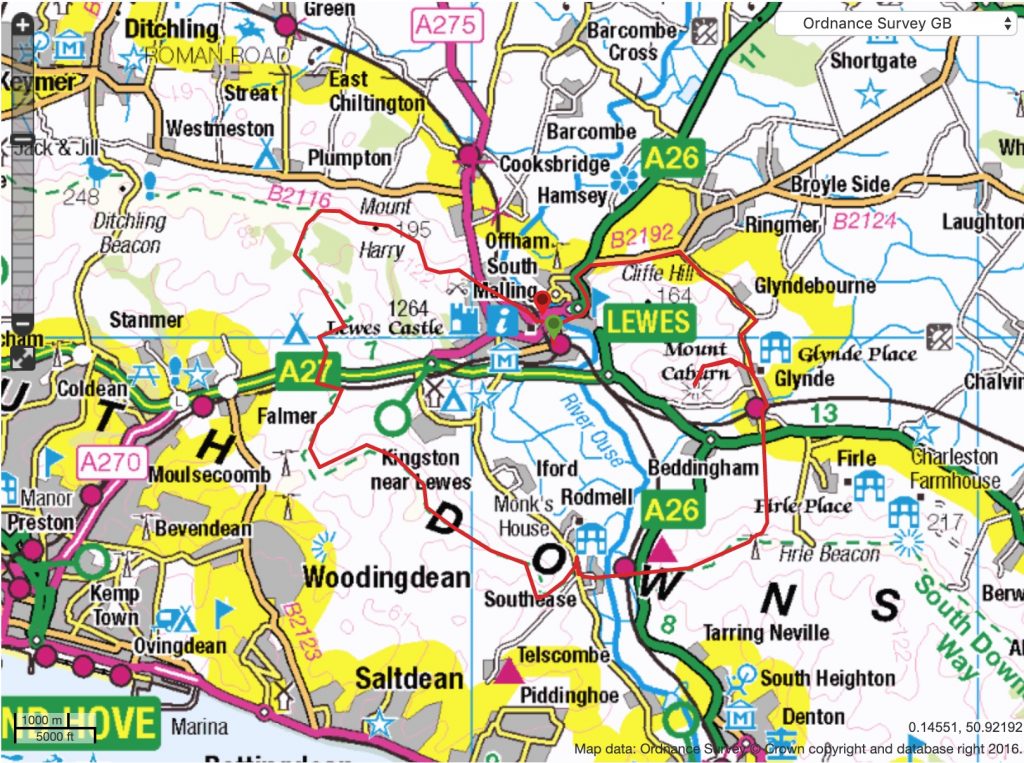The South Downs Way is something we’ve all heard of in Lewes – it goes right past the town, or through it if you want to go that way, and runs a total of 100 miles from Winchester to Eastbourne. The SDW is well known as a local trail, but it’s always surprising how many locals haven’t done it or don’t really know where it goes. The South Downs Way isn’t easy – although there aren’t any mountains, anyone who has completed it will tell you that there’s plenty of up and down involved as it crosses several river valleys on the way – about 3500 metres of ascent in all.
We contacted an old friend, Andy Gattiker, who is the South Downs Way Trails Officer for the South Downs National Park, and he gave us these stats straight from the horse’s mouth:
‘Here are a few facts and figure for you.
- Total ascent on the footpath route (going west to east) – 4276m / 14,239ft
- Total ascent on the bridleway route (going west to east) – 3795m / 12,637ft
- The trail passes through or next to 6 National Nature Reserves.
- It was the first National long distance bridleway open to horse riders and cyclists (now joined by the still unfinished Pennine Bridleway National Trail).
- Approved by the first Secretary of State for the Environment in 1963.
- The creation of the South Downs National Park in 2010 made it the only National Trail to be 100% within a single National Park.
- Most people walk the whole trail in 7 – 9 days or cycle it in 2 or 3, however the fastest run is 14 hours and the fastest cycle is 7!!
- The SDW receives millions of visits annually, largely from local people. We estimate about 20,000 aim to complete the trail each year. Many do it over multiple weekends and may take several years to walk it all.
- Data from people counters along the trail suggests 20% – 30% of all users are mountain bikers (between 1 – 5% are horse riders).
- The busiest stretch of the trail is SSCP to Beachy Head. An old people counter half way along the Seven Sisters (at least half an hour from the nearest car park) counted 400,000 people a year, 10 years ago. I think it’s safe to state this stretch receives over ½ million walkers annually. The quietest section is above Graffham in West Sussex with on average 20,000 people per year.
- 60% of all users travel west to East.’
Most people walk the South Downs Way as it started out as a footpath and is one of the National Trails like The Pennine Way, Hadrian’s Wall et al, but there’s also a cycling version on bridleways and minor roads. Quite a proportion of the South Downs Way for walkers is on bridleway anyway, so cycling it is a very similar route.
There are people who’ll try riding it in a day, but that’s pretty hardcore – you’d need to be a fit mountain biker to do it in even two days, and three is probably more realistic. For a leisurely trip take 4 or 5 days and enjoy the pubs along the way.
As for your choice of bike, the best thing would be to get out on the Downs around Lewes and see what works for you. It’ll depend of course on whether you’re carrying luggage or working from a car perhaps; an electric bike would be a great idea but if not then you’ll need at least a proper mountain bike – nothing less would do it. The South Downs Way can be slippery, rough and rutted at the best of times.
Try the Lewes Four Peaks Ride – 23 miles covering the big hills around town and a beautiful challenging ride around town. You can see it on Viewranger at: https://my.viewranger.com/route/details/MTY5OTY=


Cuckmere Haven
Some resources:
The official South Downs Way National Trails website is at: https://www.nationaltrail.co.uk/south-downs-way
There’s a nice interactive map and video of the South Downs Way here at: https://www.nationaltrailbreaks.com/en_GB/trails/south-downs-way/
One of the most 1990s websites you’ll see, but full of practical information: http://www.bikedowns.co.uk/index.html



